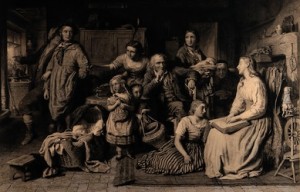W. Ridgway, after George Smith, Light and Darkness, engraving (1871). Dimensions 702 x 902mm
Wellcome Library no 574955i
George Smith’s painting from which this engraving was made was exhibited at the Royal Academy in 1865. His composition reverses the practice of early nineteenth-century voluntary societies sending out sighted people to read scripture to blind people: here, a blind girl reads aloud by touch in an attempt to convert her dissolute family. This print, given as a gift to subscribers to the Art Union in 1871, is inscribed with a passage from Luke’s gospel, and stresses how embossed literature might transform blind readers into evangelical agents – even if the results, from the limited attention span of her audience, are mixed.
George Smith (1829-1901) trained at the Royal Academy, and was a regular exhibitor there between 1848-87. Associated with the style of the Cranbrook group, whose members included Frederick Daniel Hardy and George Hardy, Smith specialised in genre subjects and rustic interiors in the vein of seventeenth-century Dutch and Flemish painters. Around the mid-nineteenth century, he had a particular interest in the theme of rural labourers and learning, depicting scenes of reading and sewing lessons in works such as Lace Making (1866), A Lesson (1866) and With the Burden of Many Years (1867). Light and Darkness (oil on panel, 455 x 610mm) did not attract much critical attention upon its exhibition at the Royal Academy in 1865 (where it was hung near to Thomas Rhodes Armitage’s brother Edward Armitage’s painting Esther’s Banquet), and was largely overlooked in contemporary reviews. It was selected five years later by the committee of the Art Union of London as a gift to their subscribers.
Art Unions were subscription societies whose members would enter an annual lottery to win an artwork selected from an exhibition. Engravings of paintings were often circulated annually as a gift to subscribers, and the Art Union of London had a wide pool of subscribers, including members in Canada and New Zealand. This meant Smith’s work would have enjoyed a wide, international circulation and indeed the engraving was reviewed in publications including the Sydney Morning Herald. Contemporary reviewers noted that the more ‘domestic’ subject of Smith’s work marked a change from the historical and literary scenes usually chosen for the Art Union of London’s engraving. These reviews noted the moral quality of the work, commenting on the earnest and beautiful countenance of the girl and the absorption of most of the family members on her words, the reviewer from the Dundee Courier & Argus noting the ‘exquisite feeling’ with which the subject had been executed.
References:
Algernon Graves, FSA, The Royal Academy of Arts: a complete dictionary of contributors and their work from its foundation in 1769 to 1904, 5 vols (S.R. Publishers Ltd; Kingsmead Reprints: Wakefield & Bath, 1970) IV.
Royal Academy Exhibition Catalogue, 1865.
The Art-Journal, No. 52, June 1870.
The Dundee Courier & Argus, November 7, 1870.
The Standard (London, England), April 27, 1870.
Sydney Morning Herald, Wednesday 11 January 1871
Object Description:
The scene is set within a dark cottage interior, populated with ten people and furnished with a selection of furniture and spinning wheel. To the right of the picture by a fireplace is seated a young blind woman approximately 18 years old, dressed in a long sleeved white blouse tucked into a long light grey-toned skirt which covers her feet. Although furthest from the window her face, blonde hair, and blouse are brightly lit. A large book volume rests on her knees which both her hands track over: lines and symbols are just discernible in the text. Her mouth is open in speech. An old woman sits immediately to her left and appears to be listening. A young girl of about twelve is sat on the floor to her left and looks at her hands; and behind her, an older man of about fifty, leaning back in a chair looks in the direction of the blind girl. A young woman of about twenty stands in between him and the old woman, holding a baby; her gaze is directed to the right, where two men of about 25 stand, linking arms, before an open door frame next to a window, discernible by a step and light on the wall. The men are half turned in the direction of the blind girl and woman with baby, but the man to the furthest left gestures outside of the door. Another woman of about twenty, standing to the right of the older seated man, is turned towards the young men, her hand reached out and pulling the sleeve of the man nearest her.

